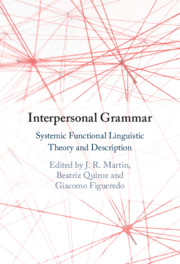Book contents
- Interpersonal Grammar
- Interpersonal Grammar
- Copyright page
- Contents
- Figures
- Tables
- Contributors
- 1 Introduction: Theory and Description in Interpersonal Grammar across Languages
- 2 Interpersonal Grammar in Spanish
- 3 Interpersonal Grammar in Khorchin Mongolian
- 4 Interpersonal Grammar in Mandarin
- 5 Interpersonal Grammar in Tagalog: Assessment Systems
- 6 Interpersonal Grammar of Pitjantjatjara
- 7 Interpersonal Grammar in Brazilian Portuguese
- 8 Interpersonal Grammar in British Sign Language
- 9 Interpersonal Grammar in Scottish Gaelic
- Index
- References
8 - Interpersonal Grammar in British Sign Language
Published online by Cambridge University Press: 21 May 2021
- Interpersonal Grammar
- Interpersonal Grammar
- Copyright page
- Contents
- Figures
- Tables
- Contributors
- 1 Introduction: Theory and Description in Interpersonal Grammar across Languages
- 2 Interpersonal Grammar in Spanish
- 3 Interpersonal Grammar in Khorchin Mongolian
- 4 Interpersonal Grammar in Mandarin
- 5 Interpersonal Grammar in Tagalog: Assessment Systems
- 6 Interpersonal Grammar of Pitjantjatjara
- 7 Interpersonal Grammar in Brazilian Portuguese
- 8 Interpersonal Grammar in British Sign Language
- 9 Interpersonal Grammar in Scottish Gaelic
- Index
- References
Summary
This chapter adds to the growing literature on the interpersonal metafunction by describing and analysing British Sign Language (BSL) from a systemic functional perspective. Whereas other chapters in this volume use the spoken and written modalities to communicate meaning, BSL operates principally in the visual-spatial modality. Nonetheless, various parallels can be drawn with other languages that have been described and analysed in SFL terms. This chapter provides a brief overview of the basics of BSL expression, focusing on the hands, upper body and space in front of a signer to give non-signing readers an insight into the basics of signed communication. Through discussions on the distinction between the planes of expression and content in BSL – and the associated difficulties when attempting to identify the distribution of semiotic labour between these planes – the interpersonal systems of MOOD, POLARITY and MODALITY are exemplified via lexicogrammatical analyses of two dialogic BSL interactions, including argumentation for a Predicator function in BSL. A full interpersonal analysis of the interactions is also presented, alongside proposals of future studies within the interpersonal metafunction and broader, more applied concerns.
Keywords
- Type
- Chapter
- Information
- Interpersonal GrammarSystemic Functional Linguistic Theory and Description, pp. 227 - 256Publisher: Cambridge University PressPrint publication year: 2021
References
- 3
- Cited by

